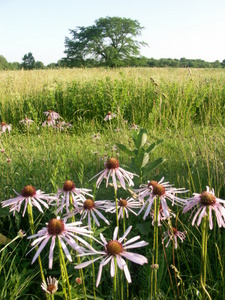Impact on Climate Change
Impact on Climate Change
 |
|
Grasslands at Midewin National Park |
Ecosystem restoration is threatened by climate change, but can also help mitigate its impacts. Humans are altering the composition of the natural landscape, as well as the Earth's atmosphere. Already, the earth's average surface temperature has increased about 1.3 degrees Fahrenheit during the last century (Snover et al. 2007). A number of repercussions are expected within the next century as a result of rising temperatures, but several effects of climate change can be observed right now. Temperature increases, receding glaciers, disappearing snowpack, premature spring seasons, shifting proportions of plants and animals, and rising sea levels have already been documented (Snover et al. 2007). Along with increased frequency and severity of droughts, flooding, forest fires and disease, these aspects of climate change have direct and indirect effects on ecosystems (Chicago Wilderness)(Sullivan and Clark 2007, 2).
The loss of ecosystems services and biodiversity, the alteration of seasonal events and the increased presence of invasive species are just some of the expected direct effects of climate change on ecosystems. Even a modest increase of a couple degrees can result in an estimated 20 to 30 percent of all known plant and animal species at risk for extinction (Snover et al. 2007). Many species (or their main source of food or habitat) can only survive in a narrow range of temperatures. As temperatures rise, those plants and animals will adapt, relocate or become extinct. In addition, the timing of critical seasonal events could be altered, causing harm to other species. For example, newborn birds depend on springtime caterpillars as food. Climate changes could result in shifted seasons and life cycles. This could also lead to changes in predator-prey relationships altering the food-chain in certain ecosystems (Sullivan and Clark 2007, 2). Increased heat and humidity in the region also perpetuate the development of insect pests and diseases that attack plants and animals resulting in highly adaptive invasive plant and animal species out-competing the native species (Ibid).
The debate surrounding climate change has shifted beyond questioning its existence to one focused on "solutions and adaptation" (Sullivan and Clark 2007, 2). Ecosystem restoration can provide some relief to the effects of climate change through increased native vegetation. Vegetation removes carbon dioxide from the atmosphere and sequesters it in its biomass thus acting as a carbon sink. This process captures gas that would otherwise contribute to global climate change. Grasslands are particularly efficient at storing carbon underground because nearly 90% of their biomass is underground (Chicago Region Biodiversity Council, 1999).
CMAP intends to take an active approach to climate change in the GO TO 2040 plan. The initial approach to the issue is laid out in a white paper on climate change (link to Volpe paper) and additional work is currently underway to inventory the region's greenhouse gas emissions and recommend actions to reduce them.